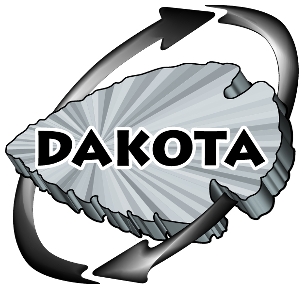Dakota: Difference between revisions
m Not markdown |
m Move todo list to end |
||
| Line 27: | Line 27: | ||
* nonlinear least squares | * nonlinear least squares | ||
* surrogate models | * surrogate models | ||
{{:Configuring_Dakota_on_beach}} | {{:Configuring_Dakota_on_beach}} | ||
| Line 49: | Line 38: | ||
* [[Building Dakota on Ubuntu 12.04 LTS]] | * [[Building Dakota on Ubuntu 12.04 LTS]] | ||
* The CSDMS Dakota Interface, [[Dakotathon]] | * The CSDMS Dakota Interface, [[Dakotathon]] | ||
== Todo == | |||
A list of topics that should be addressed in this page. | |||
Or linked to. | |||
* Talk about about the need for UQ in modeling, and how Dakota provides a framework to help. | |||
* An overview of how Dakota works. I should write this up in a more digestible manner than the way it's presented in the Dakota documentation. | |||
* A simple example of using Dakota; e.g., [https://github.com/gregtucker/simple-dakota-example Greg's]. (Make this another transcluded page.) | |||
* Installing and running Dakota on a personal computer | |||
* <s>Setting up Dakota on '''beach'''</s> | |||
* Using Dakota on '''beach''' | |||
** Link to HPCC rules | |||
** At minimum, use `qsub -I` for a single-processor job | |||
** Running Dakota in parallel with MPI | |||
Revision as of 11:12, 22 January 2017
Dakota

Dakota, developed at Sandia National Laboratories, is a software toolkit that provides an interface between computational models and a library of iterative systems analysis methods. Dakota helps answer questions such as:
- What are the most influential parameters in my model? → sensitivity analysis
- How robust and reliable is my model? → uncertainty quantification
- What is the best performing design? → optimization
- What model parameter values best match experimental data? → calibration
Dakota has an extensive library of analysis techniques, including:
- parameter studies
- design of experiments
- design of computer experiments (DACE)
- sampling (MC or LHS)
- local and global reliability
- adaptive sampling
- stochastic expansion
- epistemic methods
- gradient-based local and global optimization
- derivative-free local and global optimization
- nonlinear least squares
- surrogate models
Setting up Dakota on beach
Dakota 6.1 is installed on the CSDMS HPCC, beach.colorado.edu. To use Dakota on beach, you'll need to modify your user environment. (This only needs to be done once.)
In your favorite text editor,
open your .bashrc file
(located in your home directory)
and add the following lines to the bottom of the file:
PATH=$PATH:/usr/local/dakota/bin:/usr/local/dakota/test export LD_LIBRARY_PATH=/usr/local/dakota/bin:/usr/local/dakota/lib
Save the file, logoff from beach, then login again. Dakota will now be available for use. Check with:
$ dakota --version Dakota version 6.1 released Nov 15 2014. Subversion revision 2951 built Nov 7 2014 09:52:09.
If you encounter any problems in setting up Dakota on beach, please email the CSDMS software engineers at CSDMSsupport@colorado.edu.
Links
- The Dakota home page is https://dakota.sandia.gov
- The Dakota 6.5 (released November 2016) documentation is available at https://dakota.sandia.gov//sites/default/files/docs/6.5/html-ref/index.html
- Building Dakota on Ubuntu 12.04 LTS
- The CSDMS Dakota Interface, Dakotathon
Todo
A list of topics that should be addressed in this page. Or linked to.
- Talk about about the need for UQ in modeling, and how Dakota provides a framework to help.
- An overview of how Dakota works. I should write this up in a more digestible manner than the way it's presented in the Dakota documentation.
- A simple example of using Dakota; e.g., Greg's. (Make this another transcluded page.)
- Installing and running Dakota on a personal computer
Setting up Dakota on beach- Using Dakota on beach
- Link to HPCC rules
- At minimum, use `qsub -I` for a single-processor job
- Running Dakota in parallel with MPI
